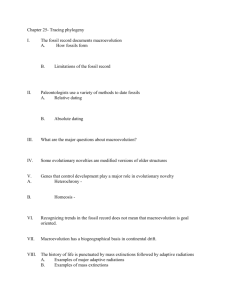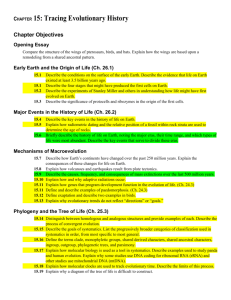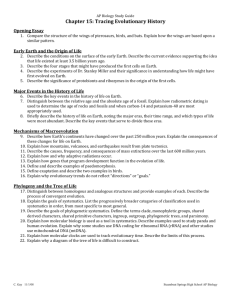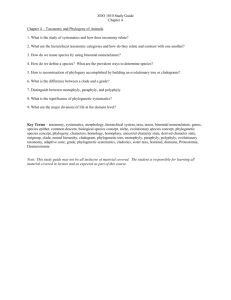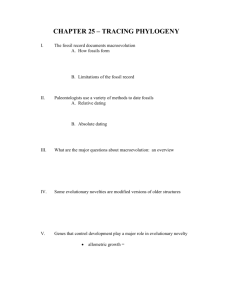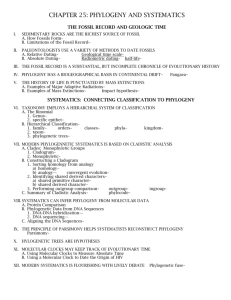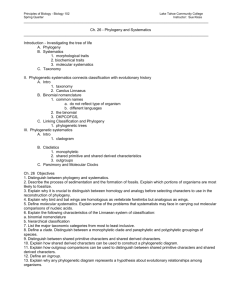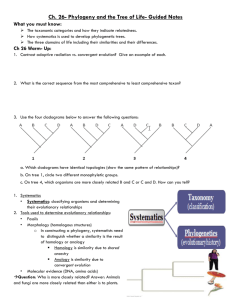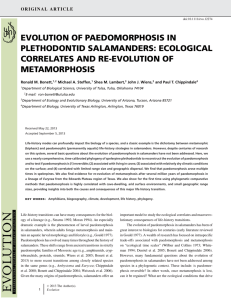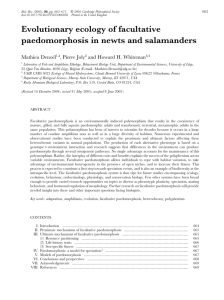CH 15 Tracing Evolutionary History
advertisement
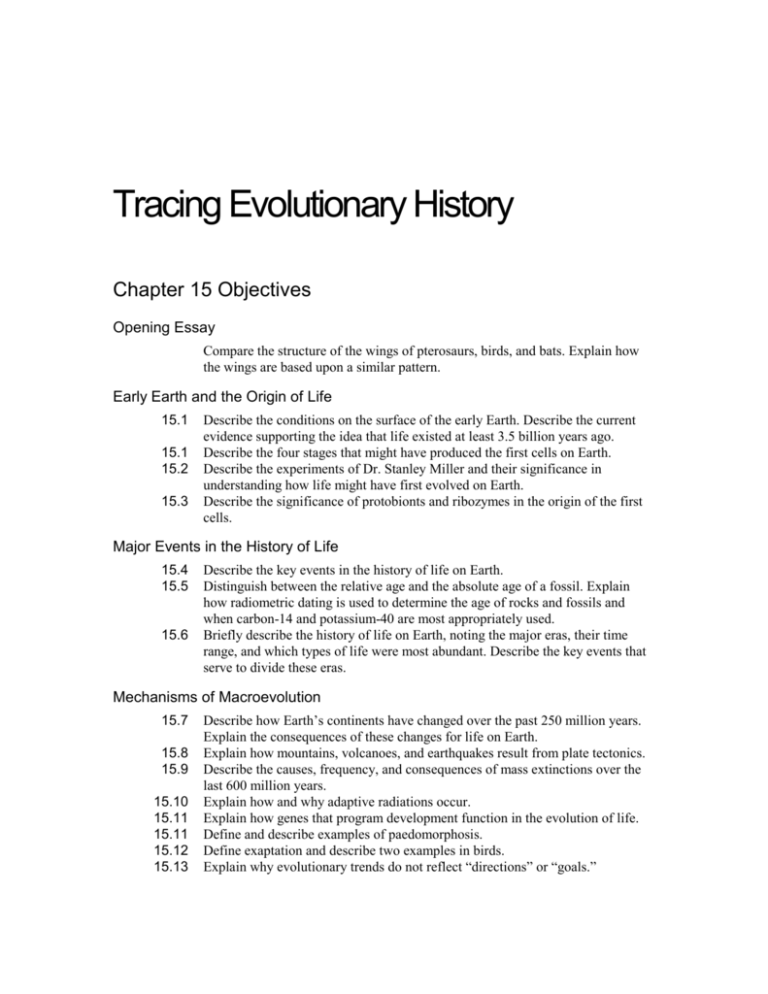
h 1 a 5 p t e r Tracing Evolutionary History Chapter 15 Objectives Opening Essay Compare the structure of the wings of pterosaurs, birds, and bats. Explain how the wings are based upon a similar pattern. Early Earth and the Origin of Life 15.1 15.1 15.2 15.3 Describe the conditions on the surface of the early Earth. Describe the current evidence supporting the idea that life existed at least 3.5 billion years ago. Describe the four stages that might have produced the first cells on Earth. Describe the experiments of Dr. Stanley Miller and their significance in understanding how life might have first evolved on Earth. Describe the significance of protobionts and ribozymes in the origin of the first cells. Major Events in the History of Life 15.4 15.5 15.6 Describe the key events in the history of life on Earth. Distinguish between the relative age and the absolute age of a fossil. Explain how radiometric dating is used to determine the age of rocks and fossils and when carbon-14 and potassium-40 are most appropriately used. Briefly describe the history of life on Earth, noting the major eras, their time range, and which types of life were most abundant. Describe the key events that serve to divide these eras. Mechanisms of Macroevolution 15.7 15.8 15.9 15.10 15.11 15.11 15.12 15.13 Describe how Earth’s continents have changed over the past 250 million years. Explain the consequences of these changes for life on Earth. Explain how mountains, volcanoes, and earthquakes result from plate tectonics. Describe the causes, frequency, and consequences of mass extinctions over the last 600 million years. Explain how and why adaptive radiations occur. Explain how genes that program development function in the evolution of life. Define and describe examples of paedomorphosis. Define exaptation and describe two examples in birds. Explain why evolutionary trends do not reflect “directions” or “goals.” Phylogeny and the Tree of Life 15.14 15.15 15.16 15.17 15.18 15.19 Distinguish between homologous and analogous structures and provide examples of each. Describe the process of convergent evolution. Explain the goals of systematics. List the progressively broader categories of classification used in systematics in order, from most specific to most general. Describe the goals of phylogenetic systematics. Define the terms clade, monophyletic groups, shared derived characters, shared primitive characters, ingroup, outgroup, phylogenetic trees, and parsimony. Explain how molecular biology is used as a tool in systematics. Describe examples used to study panda and human evolution. Explain why some studies use DNA coding for ribosomal RNA (rRNA) and other studies use mitochondrial DNA (mtDNA). Explain how molecular clocks are used to track evolutionary time. Describe the limits of this process. Explain why a diagram of the tree of life is difficult to construct. Key Terms analogy binomial clades cladistics class continental drift convergent evolution domain “evo-devo” family genus (plural, genera) geologic record horizontal gene transfer ingroup kingdom macroevolution molecular clock molecular systematics monophyletic order outgroup paedomorphosis Pangaea parsimony phyla phylogenetic tree phylogeny protobiont radiometric dating ribozyme shared ancestral characters shared derived characters species stromatolite systematics taxon three-domain system Word Roots analog- 5 proportion (analogy: a similarity between two species that is due to convergent evolution rather than to descent from a common ancestor with the same trait) bi- 5 two; nom- 5 name (binomial: a two-part Latinized name of a species) clado- 5 branch (clade: a group of species that includes an ancestral species and all its descendants; cladistics: an approach to systematics in which common descent is the primary criterion used to classify organisms by placing them into groups called clades) macro- 5 large (macroevolution: evolutionary change on a grand scale, encompassing the origin of new taxonomic groups, evolutionary trends, adaptive radiation, and mass extinction) mono- 5 one (monophyletic: a taxon derived from a single ancestral species that gave rise to no species in any other taxa) paedo- 5 child; morph- 5 form (paedomorphosis: the retention in an adult organism of the juvenile features of its evolutionary ancestors) parsi- 5 few (principle of parsimony: the premise that scientists should account for an observed phenomenon with the least complex explanation that is consistent with the facts) phylo- 5 tribe (phylum [plural, phyla]: the taxonomic category above class); -geny 5 origin (phylogenetic tree: a branching diagram that represents a hypothesis about the evolutionary history of a group of organisms; phylogeny: the evolutionary history of a species or group of related species) proto- 5 first; bio- 5 life (protobiont: an aggregate of abiotically produced molecules surrounded by a membrane or membrane-like structure) stromato- 5 something spread out; -lite 5 a stone (stromatolite: layered rocks that result from the activities of prokaryotes that bind thin films of sediment together) Student Media Early Earth and the Origin of Life Process of Science: How Might Conditions on Early Earth Have Created Life? (15.2) Major Events in the History of Life Activity: The History of Life (15.4) Activity: A Scrolling Geologic Record (15.6) Mechanisms of Macroevolution Activity: Paedomorphosis: Morphing Chimps and Humans (15.11) Activity: Mechanisms of Macroevolution (15.12) Discovery Channel Video Clip: Mass Extinction (15.9) Video: Grand Canyon (15.9) Video: Lava Flow (15.8) Video: Galápagos Islands Overview (15.8) Video: Volcanic Eruption (15.8) Phylogeny and the Tree of Life Activity: Classification Schemes (15.19) Process of Science: How is Phylogeny Determined Using Protein Comparisons? (15.17) Video: Tubeworms (15.15) BLAST Animation:
